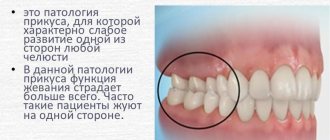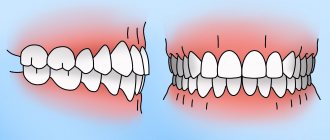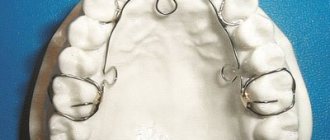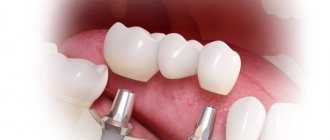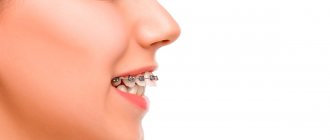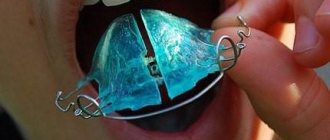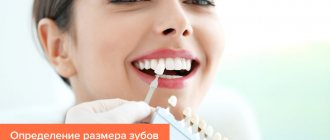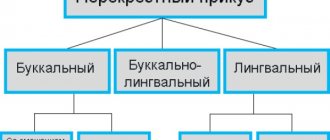Deviations in the development of occlusion, as a rule, are detected in patients of a younger age group - and already during this period it is possible to carry out therapeutic measures aimed at eliminating a specific anomaly. The Andresen-Goipl activator is prescribed in situations where correction of a mixed or permanent bite is required, and is a removable structure that is fixed on the upper and lower rows and forms a single active block that affects the jaw region. The device is created taking into account the individual anatomical features of the structure of the oral cavity, and is allowed for installation starting from the second stage of the formation of the primary occlusion, helping to eliminate cross and mixed occlusion by changing the relative position of the elements.
What is it like?
This is a removable type device, which consists of two base plates (upper and lower). They are connected to each other and form a single block. Auxiliary components of the product:
- screws, clasps, activating loops;
- retraction arch;
- guide planes;
- Coffin springs.
The upper part of the device is adjacent to the palate and surface of the tongue. It is a plate with two wings and a wire arc. The latter touches only the apex of the teeth and has loops in the area of the first premolars and canines. At the bottom there are indentations that cover the cutting surfaces of the row. A total bite gap of about 2 mm is created on the chewing planes.
Single jaw plates
They consist of a plate base with one or more orthodontic screws. This is a mechanical device, removable. It is used in primary, mixed and permanent dentition with uniformly and unevenly narrowed dentition, shortened dentition, and abnormal position of individual teeth. The principle of operation is to use the pressure that occurs when unwinding or tightening the screw spindle to uniformly or unevenly expand the dentition, move individual teeth and groups of teeth.
Mechanism of action
The Andresen-Goipl activator is a combined action device. It helps move the lower jaw forward and securely fixes it in this position. The device stops the growth of the upper jaw and stimulates the growth of the lower jaw. In addition, the functioning of the chewing and facial muscles is normalized. Additional elements help move teeth in the desired direction.
The device may have a different structure. The doctor chooses a specific design with certain elements depending on the complexity of the pathology. The jaw adjusts to the position of the activator parts.
Similar orthodontic appliances
The Andresen-Goipl activator refers to closed two-jaw orthodontic devices. However, there are also open monoblocks that do not cover the palate and the front parts of the teeth. Open ones include:
- Janson Bionator. Often used for prognathic distal occlusion. Restrains the growth of the upper row, due to which the bite is corrected.
- The Klammt activator is prescribed to correct the uncharacteristic arrangement of the anterior teeth, as well as for sagittal anomalies. The device has a lighter design compared to other devices. Due to the fact that there is no plastic on the roof of the mouth, the device does not impede speech and can therefore be used throughout the day.
- The Balters bionator is used to correct narrowing of the dentition, protrusion of the anterior teeth and deep bite, open bite and malocclusion of the lower jaw.
Considering that modern dentistry offers a wide range of options for solving the problem of malocclusion in children, parents will be able to give their child a beautiful smile.
What is a bionator and for what purpose is it used in orthodontics
The bionator is a multifunctional corrective system that allows you not only to correct rows and straighten the bite, but also to correct the position of the lower jaw pushed forward or solve the problem of abnormally sized teeth. With its help, you can change the inclination of the crowns, stimulate the muscles of the face and ligaments, and correct the width of the dentition. Experts in the field of orthodontics highlight several important advantages of using bionators, and here are the main ones:
- the design provides for strong fixing and supporting elements,
- the device provides a force sufficient for the systematic and effective movement of curved units,
- the action of the system can be aimed at expanding the jaw arch in order to free up space for the unhindered movement of problem teeth.
Bionator is a multifunctional corrective system.
The device combines the functions of several corrective systems at once. It can be used as a plate, the action of which is aimed at expanding the upper and mobile jaw, and also act as a trainer or retaining device used as part of the treatment of the temporomandibular joint.
Design features
The standard bionator model is a monoblock device with upper and lower plates interconnected. The block includes elements such as a plastic base, wire parts, expansion screw, guide slots and tilt planes.
Such devices come in single- and double-jaw types (monoblock). There are also removable, non-removable and combined models. According to another classification, bionators are therapeutic and prophylactic. The choice of a specific modification is at the discretion of the doctor and directly depends on the individual characteristics of the clinical picture.
Description of the Klammt device
This is a removable bimaxillary device , fixed on the teeth from the incisors to the second molar, leaving the frontal units and palatal vault free, which significantly expands the surface for the tongue and improves the functionality of the dental system.
The device is designed to correct the incorrect position of the anterior elements in several types of abnormal bite.
The device received its name based on the principle of operation, i.e. it is activated during movements of the tongue and jaw , for example, during communication. Bite correction is carried out by moving teeth in a small gap between the hardware arch and the dentition.
The Klammt device is an improved model of the classic Andresen-Goipl device. But unlike its predecessor, it has smaller parameters and a lightweight elastic design, which affects wearing comfort.
This is interesting: What problems do shark teeth create for humans and how to correct the situation
The device in its design has the following parts:
- two plastic shields adjacent to the alveolar areas of both jaws from molars to canines;
- overlay plates on the side units, covering 2/3 of their surface;
- clasp for the sky in the form of a spring;
- one pair of vestibular arches for the frontal elements of both jaws, which end in horizontal U-shaped bends that prevent biting of the mucous membrane.
Important! According to indications, loops for tongue retraction, spring pushers, labial pads, and half-arches can be added to the device.
Indications
The use of the system is indicated in the following clinical cases, which are various manifestations of defects in the formation of the jaw apparatus:
- distal bite – corrected with the activator of the standard version. In case of a pronounced anomaly, the device can be supplemented with finger-shaped springs, bringing the position of the units back to normal;
- distal blocking bite – the device is made individually based on a dental impression.
The system is equipped with a lip bumper, which slightly reduces muscle tone in the mouth and lips. If the incisors are atypically deployed, the arch intended for the upper row has a slightly different shape and consists of two rounded fragments; - mesial against the background of reverse incisal overlap - the arch in this case is in maximum contact with the lower jaw row, but at the same time practically does not exert any external pressure on the teeth;
- open bite – for its treatment the device is equipped with a tongue shield. Wire arches are localized on the back side of the organs and do not allow the tongue to contact the incisal units;
- protrusion - the structure is installed on the outer side of the jaw at a distance of 0.2 cm from incorrectly positioned teeth so that the arch touches them as tightly as possible;
- cross pathology - involves the use of a standard device, but with a smoother surface, which must be located further away from the side elements of the row.
Contraindications
Absolute contraindications in which the use of the device is not possible:
- allergic manifestations - as the body’s reaction to individual intolerance to the materials included in the device;
- physiological rejection of foreign objects in the oral cavity, bordering on the gag reflex.
In addition, the following relative contraindications may become a temporary limitation to carrying out correction using this method, by eliminating which the ban on treatment with the Klammt device will be lifted:
- exacerbation of serious chronic diseases;
- viral infections;
- inflammatory processes in the oral cavity;
- a number of dental diagnoses that compromise the structural integrity of teeth.
Indications and contraindications
The Andresen-Goipl device is widely used in orthodontic practice because it operates in three planes at once. The greatest effect can be achieved during the period of mixed dentition, which lasts up to approximately 12 years. The dental system is not yet fully formed and lends itself well to correction. List of indications:
- abnormally located individual teeth;
- correction of the width of the dentition;
- preventing displacement of dental units;
- distal bite;
- mesial bite;
- deep bite;
- interdental spaces.
There are very few contraindications to the use of the device. Here they are:
- allergic reaction to the materials from which the structure is made;
- nasal breathing disorder.
Manufacturing
The Goipl double-jaw apparatus must be manufactured correctly. It is necessary to take into account all the problems and characteristics of the patient’s oral cavity. This is the key to effective treatment.
Algorithm of actions when executing the device:
- Making plaster models of both jaws.
- Creation of wax templates equipped with occlusal ridges.
- Determination of occlusal relationships in the oral cavity.
- Installation of jaw models in the articulator.
- Creation of fastening elements. Manufacturing of the vestibular arch and other additional parts (if necessary).
- Creation of a wax reproduction of an orthodontic product.
- Making records.
How is the device made?
Proper manufacturing of the structure, taking into account the problem and all the features of the patient’s dental system, is a guarantee of effective and shortest possible treatment. The device is manufactured in the laboratory in several stages.
- Impressions of the patient's teeth are taken and models of both jaws are made from plaster.
- Templates with occlusal ridges are created from wax.
- The orthodontist determines the contact of the teeth of opposite jaws and their location relative to each other.
- The resulting models are installed in a special device that simulates the movements of the lower jaw.
- Next, select and manufacture all the auxiliary elements that will be used in a particular case. First of all, this is an arc, springs and screws.
- An exact reproduction of the future design is made from wax.
- Based on the results of the work done, a device is made that fully corresponds to all the individual characteristics of the patient and the tasks to be solved.
An individual approach and precision of all actions performed allow you to minimize treatment time and achieve good results, so you should contact only qualified specialists. If the doctor recommended your child to wear the Andresen-Goipl activator, then you will probably be interested in seeing this design in the final video.
Advantages and disadvantages
Treatment with this device in most cases is comfortable for the child. The device has many advantages. Among them:
- The universality of the activator action. Eliminates bite pathologies, normalizes the functioning of the facial muscles, and promotes the correct position of the tongue in the oral cavity.
- Easy care. Even a child himself can handle it. It is enough to rinse the product under warm running water and clean it with a toothbrush and toothpaste.
- Possibility to remove the structure at any time (while eating, for brushing teeth).
- No need to visit the dentist frequently.
- Efficiency.
But there are also negative aspects that parents should be aware of. The disadvantages of the activator include:
- Do not use if you have problems with nasal breathing. It completely blocks the ability to breathe through the mouth.
- The design is removable, so in the absence of discipline, treatment may not give the expected results. Parents are not always able to ensure that the child wears the device for the prescribed time.
Complications of open bite
Like any other dental pathology, an open bite can cause a number of complications. In addition to aesthetic defects, which can be expressed in a constantly open mouth, deformation of the jaw, chin and other parts of the face, this also concerns the functioning of internal organs. Especially in this case, the gastrointestinal tract suffers. Since a person with an open bite cannot fully chew food, especially hard food, it ends up in the stomach in this form. As a result, gastroenterological diseases may develop that will require serious and long-term treatment.
Another common complication is distortion of a person's speech. Since an open bite eliminates the barrier to the tongue, the opportunity for full articulation also disappears. In this regard, it becomes simply impossible to pronounce some sounds.
Important! It is necessary to remember that without correcting the malocclusion itself, it will not be possible to improve speech. Therefore, you should not waste time on speech therapists and other specialists, but it is better to immediately contact a professional orthodontist.
Wearing rules
The activator is most often worn only at night, because it makes it difficult to breathe through the mouth and talk. If the pathology is complex, then additional wearing during the daytime is recommended.
You need to visit the orthodontist every 2 weeks. The doctor activates the device, adjusts the retraction arch and adds plastic to the areas of the moved dental units (if necessary).
Design features
Bionators are divided into the following groups:
- By location - on one of the jaws, on both at the same time (i.e. monoblocks).
- By fixation - removable, non-removable, combined.
- In terms of functionality - for preventive or therapeutic purposes.
Structurally corrective devices combine elements of 2 types - active, passive:
- arcs;
- expansion parts (screws, springs);
- orienting loops;
- inclined planes.
Review of the Brückl orthodontic apparatus and the capabilities of the device.
Come here if you are interested in the manufacturing process of the Derichsweiler apparatus.
At this address https://orto-info.ru/sistemyi-vyiravnivaniya-zubov/individualno-izgotovlennyie-apparatyi/vo-vremennom-prikuse-haasa.html we will discuss the purpose of the Haas apparatus in orthodontics.
Duration of treatment
The duration of wearing an orthodontic device is determined by the severity and severity of the anomaly. Also, the individual characteristics of the patient matter. At the initial stage of correction, even an experienced specialist will not always say how long you will have to wear the device. But after the first positive changes appear, it is already possible to make an assumption about the time of removal of the structure.
The course of treatment lasts from several months to 2-3 years. On average, correction in children takes about 1 year. When wearing the product for a long time, some parts must be replaced with new ones.
The Andresen-Goipl apparatus allows you to effectively eliminate malocclusions. It helps the child achieve an even and beautiful smile even at the stage of teeth formation and growth.
Recommendations from orthodontists
In the vast majority of cases, the formation of dental defects occurs at an early age, and sometimes even at the stage of intrauterine development. In this regard, preventive recommendations from experts are aimed at caring for health, teeth and oral cavity, primarily during pregnancy, as well as in childhood and adolescence. Here's what experts advise on this matter:
- During pregnancy, increased attention should be paid to your diet, make sure that your diet contains enough vitamins and beneficial microelements,
- after the birth of the child, you need to take a responsible approach to the feeding process - the pacifier or teat should be at a right angle to the baby’s mouth,
- it is advisable to abandon nipples with an opening that is too wide - the correct formation of the jaw system requires the development of chewing muscles and the sucking reflex,
- you need to monitor the child’s behavior, try to prevent the development of the habit of thumb sucking during sleep or constantly keeping the pacifier in the mouth,
- try to control the position of the child’s head during sleep - it should not be thrown back too much or pressed to the chest,
- timely weaning off the pacifier,
- ensure complete prevention of rickets, and in this regard it is better to consult with your treating pediatrician.
Timely weaning from the pacifier is the key to a correct bite.
As soon as the first tooth appears, the child can be immediately scheduled to see a dentist. The doctor will conduct a visual examination and evaluate how correctly the process of formation of the baby’s dental system is proceeding, make sure that there are no deviations, and if there are any, he will be able to prescribe appropriate treatment in a timely manner.
And one more important rule for parents: when the first signs of caries or any other pathological phenomena appear, you should immediately show your baby to the dentist. Even if these are baby teeth that will soon fall out, treatment must be carried out without fail. Otherwise, the disease can spread to the rudiments and negatively affect permanent teeth and the bite as a whole.
1Persii L.S. Orthodontics. Diagnosis and treatment of dental anomalies: a guide for doctors, 2004.
